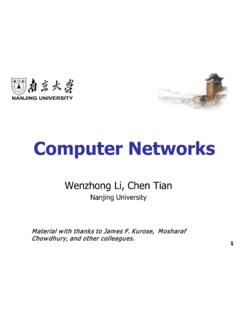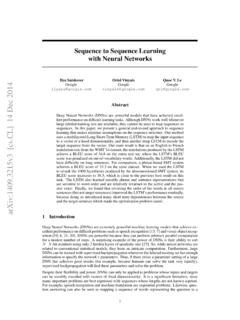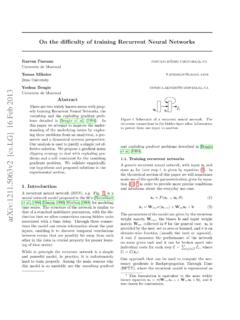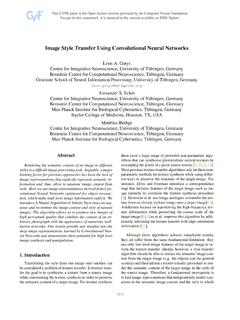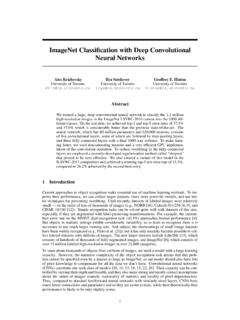Transcription of Introduction to Convolutional Neural Networks
1 Introduction to Convolutional Neural NetworksJianxin WuLAMDA GroupNational Key Lab for Novel Software TechnologyNanjing University, 1, 2017 Contents1 Introduction22 Tensor and vectorization .. Vector calculus and the chain rule ..43 CNN in a The architecture .. The forward run .. Stochastic gradient descent (SGD) .. Error back propagation ..84 Layer input, output and notations95 The ReLU layer106 The convolution What is convolution? .. Why to convolve? .. Convolution as matrix product .. The Kronecker product .. Backward propagation: update the parameters.
2 Even higher dimensional indicator matrices .. Backward propagation: prepare supervision signal for the previ-ous layer .. Fully connected layer as a convolution layer .. 227 The pooling layer2318 A case study: the VGG-16 VGG-Verydeep-16 .. Receptive field .. 279 Remarks28 Exercises281 IntroductionThis is a note that describes how a Convolutional Neural network (CNN) op-erates from a mathematical perspective. This note is self-contained, and thefocus is to make it comprehensible to beginners in the CNN Convolutional Neural network (CNN) has shown excellent performancein many computer vision and machine learning problems.
3 Many solid papershave been published on this topic, and quite some high quality open source CNNsoftware packages have been made are also well-written CNN tutorials or CNN software manuals. How-ever, I believe that an introductory CNN material specifically prepared for be-ginners is still needed. Research papers are usually very terse and lack might be difficult for beginners to read such papers. A tutorial targetingexperienced researchers may not cover all the necessary details to understandhow a CNN note tries to present a document that is self-contained. It is expected that all required mathematical backgroundknowledge are introduced in this note itself (or in other notes for thiscourse); has details for all the derivations.
4 This note tries to explain all the nec-essary math in details. We try not to ignore an important step in aderivation. Thus, it should be possible for a beginner to follow (althoughan expert may feel this note tautological.) ignores implementation details. The purpose is for a reader to under-stand how a CNN runs at the mathematical level. We will ignore thoseimplementation details. In CNN, making correct choices for various im-plementation details is one of the keys to its high accuracy (that is, thedevil is in the details ). However, we intentionally left this part out,in order for the reader to focus on the mathematics.
5 After understand-ing the mathematical principles and details, it is more advantageous tolearn these implementation and design details with hands-on experienceby playing with CNN is useful in a lot of applications, especially in image related tasks. Ap-plications of CNN include image classification, image semantic segmentation,2object detection in images, etc. We will focus on image classification (or catego-rization) in this note. In image categorization, every image has a major objectwhich occupies a large portion of the image. An image is classified into one ofthe classes based on the identity of its main object, , dog, airplane, bird, PreliminariesWe start by a discussion of some background knowledge that are necessary inorder to understand how a CNN runs.
6 One can ignore this section if he/she isfamiliar with these Tensor and vectorizationEverybody is familiar with vectors and matrices. We use a symbol shown inboldface to represent a vector, ,x RDis a column vector use a capital letter to denote a matrix, ,X RH Wis a matrix withHrows andWcolumns. The vectorxcan also be viewed as a matrix with 1column concepts can be generalized to higher-order matrices, , tensors. Forexample,x RH W Dis an order 3 (or third order) tensor. It containsHWDelements, and each of them can be indexed by an index triplet (i,j,d), with0 i < H, 0 j < W, and 0 d < D. Another way to view an order 3 tensoris to treat it as containingDchannels of matrices.
7 Every channel is a matrixwith sizeH W. The first channel contains all the numbers in the tensor thatare indexed by (i,j,0). WhenD= 1, an order 3 tensor reduces to a have interacted with tensors day-to-day. A scalar value is a zeroth-order(order 0) tensor; a vector is an order 1 tensor; and a matrix is a second ordertensor. A color image is in fact an order 3 tensor. An image withHrows andWcolumns is a tensor with sizeH W 3: if a color image is stored in theRGB format, it has 3 channels (for R, G and B, respectively), and each channelis aH Wmatrix (second order tensor) that contains the R (or G, or B) valuesof all is beneficial to represent images (or other types of raw data) as a early computer vision and pattern recognition, a color image (which is anorder 3 tensor) is often converted to the gray-scale version (which is a matrix)because we know how to handle matrices much better than tensors.
8 The colorinformation is lost during this conversion. But color is very important in variousimage (or video) based learning and recognition problems, and we do want toprocess color information in a principled way, , as in are essential in CNN. The input, intermediate representation, andparameters in a CNN are all tensors. Tensors with order higher than 3 arealso widely used in a CNN. For example, we will soon see that the convolutionkernels in a convolution layer of a CNN form an order 4 a tensor, we can arrange all the numbers inside it into a long vec-tor, following a pre-specified order.
9 For example, in Matlab, the(:)operator3converts a matrix into a column vector in the column-first order. An exampleis:A=[1 23 4], A(:) = (1,3,2,4)T= 1324 .(1)In mathematics, we use the notation vec to represent this vectorizationoperator. That is, vec(A) = (1,3,2,4)Tin the example in Equation 1. In orderto vectorize an order 3 tensor, we could vectorize its first channel (which is amatrix and we already know how to vectorize it), then the second channel, .. ,till all channels are vectorized. The vectorization of the order 3 tensor is thenthe concatenation of the vectorization of all the channels in this vectorization of an order 3 tensor is a recursive process, which utilizesthe vectorization of order 2 tensors.
10 This recursive process can be applied tovectorize an order 4 (or even higher order) tensor in the same Vector calculus and the chain ruleThe CNN learning process depends on vector calculus and the chain rule. Sup-posezis a scalar ( ,z R) andy RHis a vector. Ifzis a function ofy,then the partial derivative ofzwith respect toyis a vector, defined as[ z y]i= z yi.(2)In other words, z yis a vector havingthe same sizeasy, and itsi-th elementis z yi. Also note that z yT=( z y) , supposex RWis another vector, andyis a function , the partial derivative ofywith respect toxis defined as[ y xT]ij= yi xj.(3)This partial derivative is aH Wmatrix, whose entry at the intersection ofthei-th row andj-th column is yi is easy to see thatzis a function ofxin a chain-like argument: a functionmapsxtoy, and another function mapsytoz.
